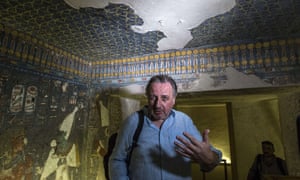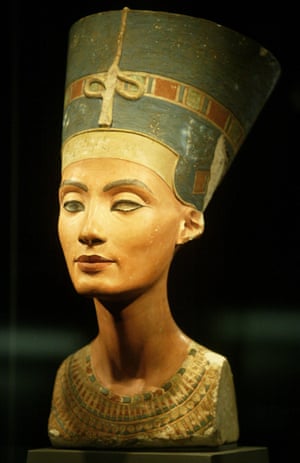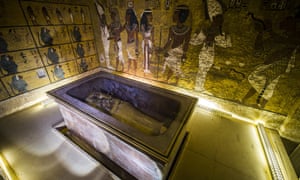Was Tutankhamun buried in someone else’s grave?
e may not have the whip, the hat, the gun, and the dusty old leather jacket, but Nicholas Reeves has a theory that is straight out of the Indiana Jones movies. Reeves, a British Egyptologist, has written a string of highly respected books, most notably The Complete Tutankhamun, and his idea certainly harks back to the golden age of treasure hunting. It is far-fetched, undoubtedly, but then that’s how Indy’s greatest adventures always started.
As the crowds flock to Tutankhamun: Treasures of the Golden Pharaoh – a recent arrival in Britain after breaking attendance records in France – Reeves believes they are being sold a dummy: that these stupendous objects were not made for the Egyptian boy king and his journey into the afterlife at all. So who were they for? “I reckon,” says Reeves, “almost all the burial equipment for Tutankhamun was originally made for Nefertiti.”
It is a sensational claim. Do these extraordinary relics really belong to the Egyptian queen? What we do know for certain is that Howard Carter’s discovery of Tutankhamun’s tomb in 1922 is the most celebrated moment in archaeology. It even sparked the legend of a curse, whose alleged victims include Archibald Douglas Reid, a radiologist who supposedly died mysteriously after X-raying the mummy; Arthur Mace, one of the dig team, believed to have succumbed to arsenic poisoning; and Richard Bethell, Carter’s secretary, thought to have been smothered in his bed.
If Reeves is right, even this needs revising: we should instead fear “the Curse of Nefertiti”. Reeves thinks it is the very opulence of Tutankhamun’s tomb that has stopped archaeologists digging deeper. “The gold,” he says, “has just dazzled everyone.” It was certainly what entranced the adventurers who first peered into the miraculously unspoiled tomb.

Known to specialists as KV62, the tomb was in the Valley of the Kings, where many pharaohs were buried. Carter had been a digger since 1907, funded by the Egyptomaniac Lord Carnarvon. By 1922, Carnarvon was getting frustrated by the lack of glittering discoveries. Fortunately, Carter had “a superstitious feeling” that there might be something hidden under some huts in a neglected part of the valley.
His Egyptian workforce soon found a step down into the earth. Then, having excavated a buried stairway leading to a passage, Carter made a hole in an ancient door. “Yes,” he replied when Carnarvon asked if he could see anything. “Wonderful things!” They’d found the tomb of Tutankhamun, so perfectly preserved that even it’s funeral flowers lay desiccated where they had been strewn in about 1325 BC.
In the antechamber, they saw chariots in kit form, ready to assemble themselves in the afterlife, carved animals, alabaster jars, treasure chests – “and gold,” raved Carter, “everywhere the glint of gold.” Two gilded statues of Tutankhamun’s ka, the soul that must be sustained after death, stood guard over a second sealed doorway that led to Tutankhamun’s painted burial chamber and his mummy.
But did the British explorer have a hunch there was more to find? Reeves mentions a part of the north wall of the burial chamber that, according to before and after photographs, seems to have been clumsily restored, with splashes of paint used to recreate mold. In other words, he believes Carter did something to the wall, then covered his tracks.
“He was a cunning beast,” says Reeves, who thinks he wanted to see what lay beyond, believing there might be more chambers. And his hunch was right, according to Reeves, who thinks the young king was buried in part of Nefertiti’s tomb, where she still remains hidden in an un-excavated space. In a new study highlighting certain anomalies, Reeves claims the paintings in Tutankhamun’s burial chamber, even the gold death mask, either portray Nefertiti, or did so initially before being adapted. His reference point is the famous bust of Nefertiti discovered almost a century ago, noted for its incredible realism.
Why make these adaptations? Well, it was common in ancient Egypt for funeral art to be recycled. It was expensive, after all, and when the tomb was sealed, who would know the difference? It’s certainly striking how ambiguous the gender of Tutankhamun appears in some treasures. Was he an exceptionally graceful looking youth – or were these reworkings from Nefertiti’s bounty? At least one statue in the exhibition gives him prominent breasts. “KV62,” says Reeves, “looks like it began life as a queen’s tomb.”
But his theory doesn’t stop there. Tutankhamun was the son of a king, Amenhotep IV, who overturned this civilization’s pantheon of animal-headed deities and replaced them with a new sun god, Aten. He even renamed himself Akhenaten, meaning “Aten’s representative on earth”.
Akhenaten ordered artists to stop using their idealized style and employ instead a grotesque yet lifelike manner. After Akhenaten died, there followed a series of short-lived rulers as politics – and art – recovered. Crucially, some Egyptologists believe that Nefertiti, Akhenaten’s famous Queen, even became pharaoh herself. This would make Tutankhamun her successor. By the end of his 10-year reign, the previous gods were fully restored. We know this because their images appear in his tomb, created in the old idealized manner.

There is one painting there – reproduced in the Saatchi exhibition – of a ritual that only one pharaoh could perform for another. It is the Opening of the Mouth: touching a mummy on the lips with an incense-burner to enable the dead to live again. This painting has been traditionally identified as the opening of Tutankhamun’s mouth by his successor Ay. But Ay was an old man, says Reeves, and this work clearly depicts a youth. Reeves thinks the toucher looks like Tutankhamun while the mummy has the appearance of “a woman – and one with features that correspond closely to Nefertiti”.
There is also the tomb’s shape. The ground plan shows that it turns to the right from its entrance, which was the Egyptian pattern for the burial of a queen, whereas a king’s turned left. Carter probably didn’t know that. If he’d dug into the other end of that wall, he might have found Nefertiti’s sarcophagus.
Reeves began to formulate his theory after seeing a 3D scan of the tomb made by Factum Foundation, world leaders in such work. After spotting oddities, he went public with his Nefertiti proposition. The Egyptian government authorized surveys, using ground-penetrating radar that can locate cavities underground. Last year, on the basis of an Italian study, it announced there was nothing to find. The story died.
My theory has probably not improved my employment prospects. It has ruffled a lot of feathers
But Reeves published a reassessment, arguing that the Italian study was out of sync with other independent surveys, all of which concluded there may be secret chambers. As Adam Lowe, founder of Factum Foundation puts it: “There have actually been four radar tests and three suggest he’s right.”
The Egyptian government’s declaration last year that there was no evidence for hidden chambers led National Geographic magazine to withdraw support for Reeves’ hypothesis. But he is standing firm. “It’s probably not improved my employment prospects,” he says. “It’s ruffled a lot of feathers.”
Carter would have sympathized, for his own achievement soon turned sour. In 1923, Lord Carnarvon died in agony after a mosquito bite turned septic. The elderly Arthur Conan Doyle – author of spooky Egyptian stories, a believer in spirits, creator of Sherlock Holmes – told reporters the death was caused by supernatural forces. Does the curse stand up? Well, to take one example, while Reid’s death was put down to the “fact” he X-rayed Tutankhamun, no such X-ray survives and his obituary blamed exposure to radiation.

Yet behind the hokum, there may lurk something just as intriguing. In 1922, Egypt was dominated by European empires but was starting to assert its national identity. Unlike many archaeologists before him, who’d carted off everything from the Rosetta Stone to Nefertiti’s portrait, Carter lost control of Tutankhamun’s treasures. They stayed in Cairo: this current tour is a farewell, before they take up a permanent home in the new Grand Egyptian Museum, close to the pyramids.
The field of Egyptology is still one in which teams from old imperial powers – Britain, France, Italy – and new global players such as China compete with Egypt itself for the glory of making new discoveries. Egypt’s ownership of Tutankhamun’s treasures is a major asset in its desire to assert control over its own past. Reeves thinks these politics of heritage have bedeviled what could be the greatest find since Carter’s.
His view is backed up by Lowe, a highly respected expert currently working with the British Museum and the Grand Egyptian Museum. Lowe thinks the authorities may want the Nefertiti story to die for now, in the interests of news management – for we are just three years from the centenary of Carter’s find. “My suspicion,” he says, “is that 2022 will be a great time to announce the new discovery.”
As the closest thing there has ever been to a real-life Indiana Jones, Carter is often seen as an aberration in modern archaeology. But now, in his wake, come such adventurous characters as Reeves and Lowe, daring to dream of ancient chambers and treasures so wondrous they might dwarf even Tutankhamun’s. Grab your whip, Indy, and get ready for Raiders of the Lost Sarcophagus.
The post Original tomb raider: was Tutankhamun buried in someone else’s grave? appeared first on The Guardian.
See all posts in Biblical Archaeology News & Opinion
Upcoming Tours
We would love to walk with you in the Holy Land. Here are upcoming opportunities:
Jun 27 — Jul 09, 2024 Egypt & Jordan Walking Tour (easy pace)Led by George DeJong |
All trip dates subject to change.